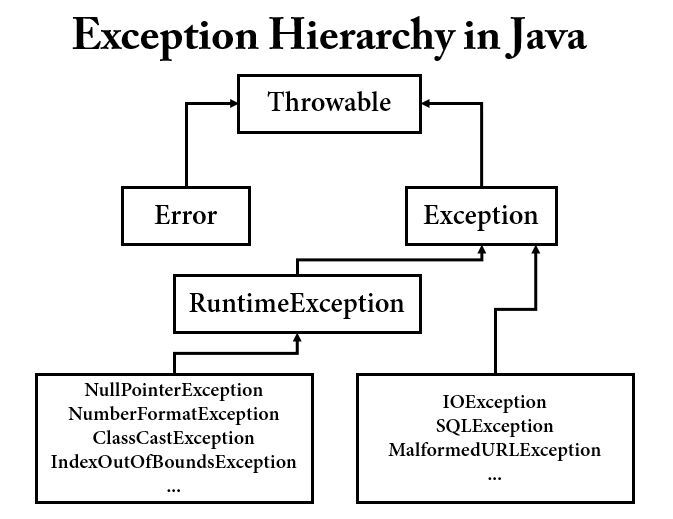Exception Hierarchy
- Exception Hierarchy
- Checked, UnChecked Exceptions
- Harmful SQLException was removed
- How to Design Exception Hierarchy
- References
Exception Hierarchy
Exception Format is very important in Application Architecture.

Checked, UnChecked Exceptions
CheckedException 은 Spring 에서 rollback 하지 않는 것을 기본 전략으로 하고 있다. (The Exception itself is not relevant to the transaction.)
CheckedException has Recoverable Mechanism. However, in reality, when a Checked Exception occurs, it is not often possible to recover with a recovery strategy. This is especially true of SQLException.
SQLException(e.g Duplicated UniqueKey) 처럼 CheckedException 을 만나면, 더 구체적인 UncheckedException 을 발생 시켜서 정확한 정보를 전달해야 한다.
Rollback able CheckedException in Spring:
@Transactional(rollbackFor = {SQLException.class})
public void create(Member member) throws SQLException {
// JDBC API
}
Harmful SQLException was removed
스프링 JdbcTemplate 은 SQLException(Checked Exception) 을 DataAccessException(UncheckedException) 로 포장하여 예외를 던진다.
이렇게 예외를 전환 하는 목적 은 다음과 같다.
- 런타임 예외로 포장하여 불필요한 catch/throw 를 줄여주는 것
- 로우 레벨의 예외를 좀 더 의미 있고 추상화된 예외로 바꾸어 주는 것
대부분 스프링 API 메서드에 정의되어 있는 대부분의 예외는 런타임 예외이다.
DB 를 사용하다보면 발생할 수 있는 예외의 원인들이 다양하다. 커넥션 문제, 문법 문제, 키가 중복되는 문제 등이 있을 것이다. 문제는 DB 벤더 마다 이러한 에러의 종류와 원인들이 제각각이다. 그래서 JDBC 는 데이터 처리 중에 발생하는 다양한 예외를 SQLException 하나에 담아버린다. 즉, JDBC API 는 SQLException 한 가지만 던지도록 설계되어있다. 따라서 DB 에 독립적인 유연한 코드를 작성하기 어렵다.
이러한 문제를 해결하고자 스프링 JdbcTemplate 이 SQLException 을 DataAccessException 으로 예외 전환을 하는 것이다. DataAccessException 서브 클래스에서는 데이터 처리 중에 발생할 수 있는 예외들에 대해서 세분화하여 정의하고 있다. 따라서, JdbcTemplate 이 DB 의 에러 코드를 DataAccessException 계층 구조의 클래스 중 하나로 매핑해준다.
이러한 이유들로 인해서 JdbcTemplate 에서는 SQLException 이 사라지게 되었다.
How to Design Exception Hierarchy
In practice, Exception Hierarchy is very important.
First Step - Define common specifications for exception classes:
/**
* Top of Exception Hierarchy extends RuntimeException
* Is not empty customErrorMsg ? customErrorMsg : errorMsg in Database
*/
abstract class CustomException: RuntimeException {
private var errorType: ErrorType
private var customErrorMsg: String? = null
private var args: MutableList<Any>
constructor(errorType: ErrorType, customErrorMsg: String? = null) {
this.errorType = errorType
this.customErrorMsg = customErrorMsg
this.args = mutableListOf()
}
constructor(errorType: ErrorType, vararg args: Any) {
this.errorType = errorType
this.args = args.toMutableList()
}
fun getErrorType() = errorType
fun getCustomErrorMsg() = customErrorMsg
fun getArgs() = args
}
Second Step - Create a Sub exception classes:
class OutOfStockException: CustomException {
constructor(errorType: ErrorType, vararg args: Any): super(errorType, args)
constructor(errorType: ErrorType, customErrorMsg: String? = null) : super(errorType, customErrorMsg)
}
class DuplicatedMemberException: CustomException {
constructor(errorType: ErrorType, vararg args: Any): super(errorType, args)
constructor(errorType: ErrorType, customErrorMsg: String? = null) : super(errorType, customErrorMsg)
}
Layer 별로 DomainException, InfraException 등을 만들고 ErrorType 으로만 구분할 수도 있을 것이다.
throw DomainException(ErrorType.OutOfStock)
위 처럼 사용할 경우 몇가지 단점이 있다.
- 코드가 길어진다. 생성자에 항상 ErrorType 을 할당해야 한다.
- (Important!!) 모니터링에서 불편하다.
두 번째가 정말 큰 단점이라고 생각한다.
Datadog 같은 Monitoring Tool 을 사용하는 경우 APM(Application Performance Monitoring) 에서 ErrorType 으로 필터링을 할 수 있다. 어떤 에러가 빈번하게 발생했는지 발생 빈도 횟수도 보여준다.
Filtering by ErrorType:
Search for: env:real error.type:org.dope.backend.server.api.base.exception.OutOfStockException
APM Dashboard 를 구성할 때 Issues 에서 ISSUE DETAILS 를 구성하는 항목이 Java 의 경우에는 Exception 이름이다.
따라서 예외가 세분화되어있으면 어떤 예외가 발생 빈도가 높은지 파악하기 수월하다.
References
- 토비의 스프링 3 / 이일민 저 / 에이콘 출판사